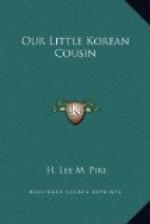The temple buildings, with deep curved roofs, are in a glorious situation on a small level lot of grassy land crowded between the high walls of a rocky ravine.
Yung Pak was delighted at his first sight of the great temple and the surrounding buildings. Through the swaying branches of the forest-trees he caught brief glimpses of the granite walls and turrets reddening in the sunset glow. The deepening gloom of the gorge was lighted by the slant beams of the setting sun, and on the water in the stream below flecks of foam sparkled and danced in the light of the dying day.
At first conversation was out of the question in the presence of such a majestic display of nature’s wonders combined with the handiwork of man.
Coming to a gate of red stone, Yung Pak asked the meaning of the carved arrow in the arch overhead.
“That arrow,” replied his father, “signifies that the temples to which this gate is the outer entrance are under the patronage of the king. Wherever you see that sign, you may know that the king has a special interest, and his messengers will be treated with respect and hospitality. Consequently we may expect to be well cared for during our visit to this place.”
Passing through the gate, our friends found themselves at once in the midst of the Chang-an-sa monastery buildings. In addition to the great chief temple, there were many smaller places of worship, with bell and tablet houses. There were also cells and sleeping-rooms for the monks, servants’ quarters, stables, a huge kitchen, and an immense dining-room, together with a large guest-hall and a nunnery. In addition there were several buildings devoted to the care of the aged, the infirm, and the sick. All these places, during his stay, Yung Pak visited in company with Wang Ken and guided by one of the monks.
Besides the buildings already mentioned there were several houses that had been erected by the king on purpose for the use of his officials, and it was to one of these that Ki Pak and his son and Wang Ken were led by several of the priests of the monastery. In the meantime, the servants and the ponies were cared for in other places assigned for the purpose.
Yung Pak was not sorry to arrive at his journey’s end, even though he had enjoyed himself every moment of the time since he left Seoul. A four days’ ride on the back of a pony will make the most enthusiastic traveller tired, and Yung Pak was glad to get to bed in the comfortable room provided just as soon as he had eaten his supper. His night’s sleep was a sound one, though at midnight, and again at four o’clock in the morning, he was awakened by the ringing of bells and gongs that called the monks to the worship of Buddha.
In the morning Yung Pak awoke greatly refreshed, and, after a bountiful breakfast, he started out with Wang Ken, guided by a monk, to see the wonders of Chang-an-sa monastery.
One of the first things he noticed was the large number of boys about the place. He learned from the guide that these lads were all orphans who were being cared for by the priests, and who, later in life, would themselves become priests of Buddha. They were all bright and active, and were kept busily employed as waiters and errand-runners when they were not at work on their studies. Like most boys, however, they managed to get a generous share of time for play.




